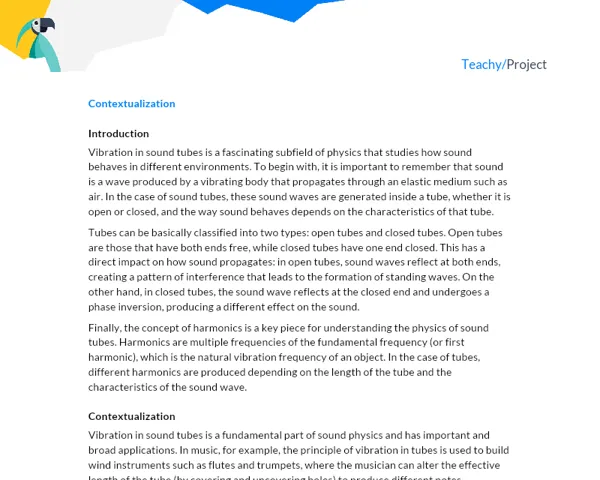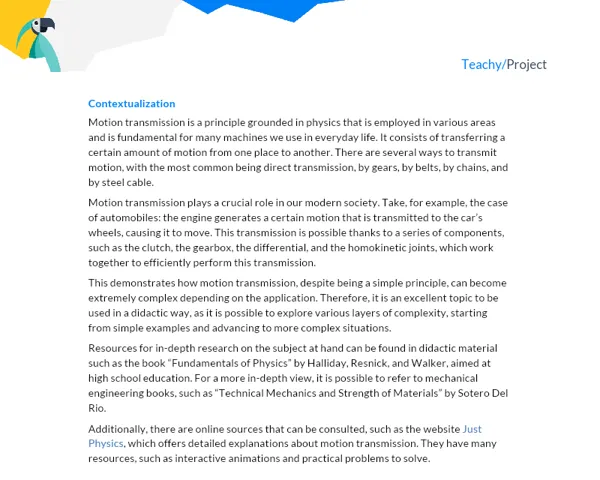Context
Introduction
In physics, collisions are fundamental events for understanding how matter interacts and moves. When discussing collisions in one dimension, we are referring to events where only one axis of movement is relevant, usually the horizontal displacement. These collisions can be classified as elastic and inelastic. Elastic collisions are those that conserve the total kinetic energy of the system, while inelastic collisions do not conserve this energy, but both follow the conservation of momentum.
To delve into the concept, we need to understand some fundamental physical laws. Newton's First Law, or the law of inertia, tells us that an object at rest tends to remain at rest, and an object in motion tends to remain in motion unless acted upon by an external force. Newton's Second Law informs us that the acceleration of an object is directly proportional to the force applied to it and inversely proportional to its mass. Finally, Newton's Third Law, or the action-reaction law, states that for every action, there is an equal and opposite reaction.
Furthermore, we need to understand the concept of Impulse, which is the force applied to an object over a certain period of time and is directly related to the change in the object's momentum. And the Principle of Conservation of Momentum, which states that the total amount of momentum of an isolated system is constant, no matter what interactions are occurring within it.
Context
One-dimensional collisions have a wide range of practical applications and are present in our daily lives in various ways. Whether in traffic, in sports like soccer and billiards, or in rarer but still present events, such as asteroid collisions in space.
Understanding the physics behind these events can help us predict and, in some cases, prevent accidents in traffic, for example. Dynamics calculations of collisions can guide the design of vehicles to ensure passenger safety in case of accidents.
In sports, understanding collisions can improve athletes' performance. In soccer games, collision physics is vital to understand how a ball will react to a kick, while in a billiards game, a good player must be able to predict the trajectory of the balls after the collision.
Practical Activity
Activity Title: One-Dimensional Collisions: The Physics of Billiards
Project Objective:
To investigate in practice the theory behind one-dimensional collisions and the conservation of momentum and kinetic energy. Students will conduct experiments using billiard balls and record their observations for further analysis. The activity will also involve the application of mathematical concepts to analyze the collected data.
Detailed Project Description:
Students will divide into groups of 3 to 5 members. Each group will be responsible for conducting a series of controlled experiments using billiard balls on a billiard table. Through these experiments, students will be able to observe firsthand the principles of conservation of momentum and kinetic energy in action.
Students should record their observations, collect data, and perform analyses. They will also be encouraged to discuss their observations among themselves and with other groups, thus promoting a collaborative learning environment. The project is expected to last approximately 12 to 15 hours for each student, spread over a few weeks.
Required Materials:
- Billiard balls (at least 3)
- Billiard table
- Tape measure
- Camera or cell phone to record experiments
- Paper and pen for notes
Detailed Step-by-Step Guide for Activity Execution:
-
Initially, students should review the theory of one-dimensional collisions, conservation of momentum, and conservation of kinetic energy. This is crucial for understanding the experiment.
-
The groups will conduct a series of controlled experiments with billiard balls. Ideally, this should be done on a billiard table, but any flat surface will suffice.
-
Students will place two balls in a straight line on the billiard table and push a third ball towards them. They should observe and record what happens after the collision.
-
The groups should perform at least five versions of this experiment, changing variables such as the force with which the ball is pushed and the position of the balls on the table.
-
Students should observe and record the movement of the balls after the collision, as well as any patterns that become apparent.
-
Students will collect data during their experiments, such as the distance traveled by the balls after the collision. They will use this data to calculate the momentum and kinetic energy of the balls before and after the collision.
-
After completing the experiments, the groups will analyze the collected data and discuss their observations. They should then compare their results with the theory to see if they corroborate the laws of physics studied.
-
Students will discuss their observations and conclusions with the other groups, and then prepare a written report of their results, discussions, and conclusions.
Project Deliverables:
Each group should prepare a detailed written report of the project, which should be presented to the teacher. The report should include the following elements:
1. Introduction: Provide context for the theme, explain its relevance and real-world application, and describe the objective of this project.
2. Development: Explain the activity in detail, including the theory behind one-dimensional collisions, the methodology used, and the presentation and discussion of the results obtained.
3. Conclusions: Draw conclusions about the project, the learnings obtained, and the connection between the results obtained in the experiment and the theory studied.
4. Bibliography: The sources used to work on the project, including books, websites, videos, etc.
Students should also prepare an oral presentation of the experiment results and conclusions for the class, aiming to share the knowledge acquired and stimulate discussion among peers.



